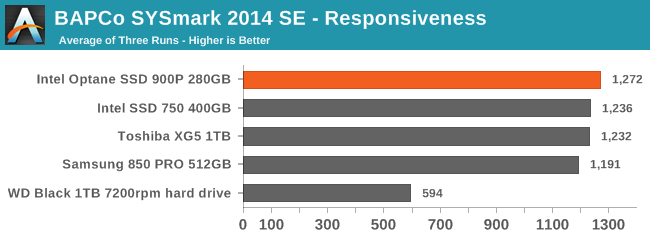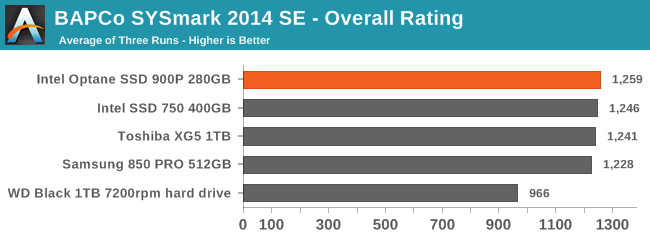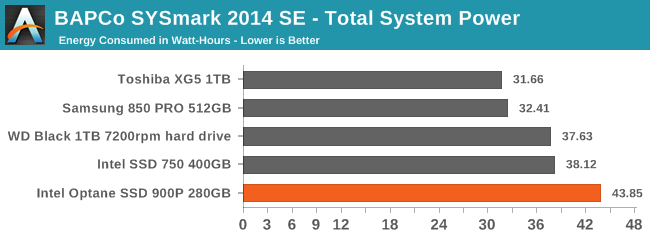The Intel Optane SSD 900P 280GB Review
by Billy Tallis on October 27, 2017 9:30 AM ESTBAPCo SYSmark 2014 SE
BAPCo's SYSmark 2014 SE is an application-based benchmark that uses real-world applications to replay usage patterns of business users in the areas of office productivity, media creation and data/financial analysis. In addition, it also addresses the responsiveness aspect which deals with user experience as related to application and file launches, multi-tasking etc. Scores are calibrated against a reference system that is defined to score 1000 in each of the scenarios. A score of, say, 2000, would imply that the system under test is twice as fast as the reference system.
SYSmark scores are based on total application response time as seen by the user, including not only storage latency but time spent by the processor. This means there's a limit to how much a storage improvement could possibly increase scores, because the SSD is only in use for a small fraction of the total test duration. This is a significant difference from our ATSB tests where only the storage portion of the workload is replicated and disk idle times are cut short to a maximum of 25ms.
| AnandTech SYSmark SSD Testbed | |
| CPU | Intel Core i5-7400 |
| Motherboard | ASUS B250-PLUS |
| Chipset | Intel B250 |
| Memory | 2x 8GB Kingston DDR4-2400 CL17 |
| Case | In Win C583 |
| Power Supply | Cooler Master G550M |
| OS | Windows 10 64-bit, version 1703 |
Our SSD testing with SYSmark uses a different test system than the rest of our SSD tests. This machine is set up to measure total system power consumption rather than just the drive's power.


SYSmark 2014 SE doesn't come close to stressing the storage system enough to show meaningful distinctions between high-end NVMe SSDs. The Responsiveness sub-test is the most sensitive to storage performance, and only shows a few percent difference between most SSDs. The overall test barely registers a difference at all. But with my primary power meter broken, SYSmark does provide a rough assessment of how power hungry the Intel Optane SSD 900P is:

The SYSmark energy usage scores measure total system power consumption, excluding the display. Our SYSmark test system idles at around 26 W and peaks at over 60 W measured at the wall during the benchmark run. SATA SSDs seldom exceed 5 W and idle at a fraction of a watt, and the SSDs spend most of the test idle.
Despite being the fastest drive in this bunch and thus the one with the shortest SYSmark run times, the Optane SSD 900P used far more energy over the course of the three SYSmark runs. With higher idle power than even the Intel SSD 750 and similar power draw under load, the Optane SSD 900P really needs its heatsink. Intel is a very long way off from being able to package this level of performance in a M.2 SSD.










205 Comments
View All Comments
Hurr Durr - Friday, October 27, 2017 - link
He desperately needs some CNC time to calm down, be merciful.Reflex - Friday, October 27, 2017 - link
We need to compile a list of all the things you supposedly have been doing. I mean seriously, anything anyone brings up as a use case supposedly you've been doing forever at a professional level. And you use that imagined position to then attempt to clobber their own assertions about its applicability in the field they are discussing.ddriver - Friday, October 27, 2017 - link
What can I say, I am a renaissance man. Also known as a polymath. I have scores of interests in all sorts of fields or science, arts and crafts, and I have employed many of those to make a living over the years. Where you collect pokemons, or postal stamps, or baseball hats or whatever, I collect skill and knowledge. Even the act of commenting here is part of my studies, social and psychological.Reflex - Friday, October 27, 2017 - link
Not only have you pursued your 'scores' of interests, you are the expert in all of them! We are truly gifted by your presence, I cannot wait to read your memoirs....MarceloC - Friday, October 27, 2017 - link
"What can I say, I am a renaissance man. Also known as a polymath. I have scores of interests in all sorts of fields or science, arts and crafts, and I have employed many of those to make a living over the years. Where you collect pokemons, or postal stamps, or baseball hats or whatever, I collect skill and knowledge. Even the act of commenting here is part of my studies, social and psychological."LOL LOL LOL!
sor - Friday, October 27, 2017 - link
You clearly don’t care about immediate persistence, consistent performance, or random reads.The numbers make a clear argument that Optane won’t be all that helpful for light workloads, but we already expected that; there’s only so much super fast IO can do for you if you’re not using IO.
I’d say those insane random reads and improved latencies live up to 3D Xpoint. There may be some elements to improve on but it is clear we are looking at a different, superior tech at a cost that is surprisingly affordable. Much of the initial talk about Xpoint was around whether or not it was real, if it was a hyped twist on regular flash, it seems clear it is a different animal.
ddriver - Friday, October 27, 2017 - link
You clearly didn't pay attention to what I've written. I did indeed acknowledge the random reads as an obviously strong point.Judging by the "destroyer", it won't be that helpful in heavy workloads either. In fact, contrary to what you say, where it shines the most is exactly light workloads, which is what low QDs are. Push higher queue depths and NVME catches up.
Lolimaster - Saturday, October 28, 2017 - link
With most work using big files, 4k random performance is meaningless, everything is linear so huge sustained write/reads are prefered. 960EVO/Pro wins.ionstorm66 - Sunday, October 29, 2017 - link
I wonder how much more performance that same test system would get if it had 128GB of ram. The 900P 280GB is 389 bucks, 64GB kit of ram is 500 bucks. I'd take 64GB of system memory over 280gb of ssd storage anyday, especially with a system with a 960 pro already.mapesdhs - Tuesday, October 31, 2017 - link
Unless of course you're doing something that needs ECC, in which case that cost comparison is rather wide of the mark.